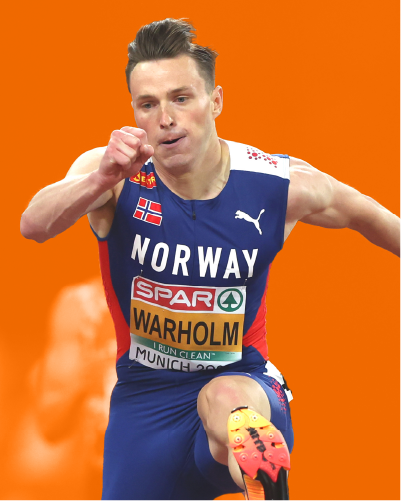Karsten Warholm
Date of birth
February 28, 1996
Weight
78 kg
Height
1,87 cm
Nationality
Norway
Date of birth
February 28, 1996
Weight
78 kg
Height
1,87 cm
Nationality
Norway
Karsten Warholm was born in Ulsteinvik, Norway, on February 28, 1996. An Olympic champion and world record holder in the 400 hurdles, Warholm is an extraordinary athlete, capable of combining speed, endurance and agility.
Early career
He began athletics when he was only 14 years old and immediately distinguished himself for his physical and technical prowess. In 2013, at only 17 years old, he won his first international medal, gold at the U18 World Championships in Donetsk in the multiple events (Octathlon).
Since 2016 Warholm has made the decision to focus exclusively on the 400-meter hurdles as his main discipline and the 400-meter flat.
In the following years, Warholm continued to improve his performance, winning numerous medals at the international level, including gold at the 2019 World Championships in Doha, with a time of 47.42.
The year 2021 was the year of ultimate consecration for Warholm: at the Olympic Games in Tokyo, the Norwegian won the gold medal with a time of 45.94, erasing the previous world record of 46.78 that had belonged to Kevin Young since 1992, thus becoming the first athlete to have gone under 46 seconds in the 400 hurdles.
In 2022, Warholm continued to win medals, winning a gold at the European Championships in Munich.
One year later, he turns up at the World Championships in Budapest 2023 in top form: the Norwegian closes his race in 46.89, winning gold and confirming himself as the ruler of his discipline
Warholm is used to cold temperatures, so much so that when he is at home in Norway, he trains shirtless and in shorts even if there is snow on the ground.
The running shoes he uses during competitions have a special feature: his toes are plated with carbon, which were also developed thanks to technology used by the Mercedes Formula 1 team.
Karsten Warholm was born in Ulsteinvik, Norway, on February 28, 1996. An Olympic champion and world record holder in the 400 hurdles, Warholm is an extraordinary athlete, capable of combining speed, endurance and agility.
Early career
He began athletics when he was only 14 years old and immediately distinguished himself for his physical and technical prowess. In 2013, at only 17 years old, he won his first international medal, gold at the U18 World Championships in Donetsk in the multiple events (Octathlon).
Since 2016 Warholm has made the decision to focus exclusively on the 400-meter hurdles as his main discipline and the 400-meter flat.
In the following years, Warholm continued to improve his performance, winning numerous medals at the international level, including gold at the 2019 World Championships in Doha, with a time of 47.42.
The year 2021 was the year of ultimate consecration for Warholm: at the Olympic Games in Tokyo, the Norwegian won the gold medal with a time of 45.94, erasing the previous world record of 46.78 that had belonged to Kevin Young since 1992, thus becoming the first athlete to have gone under 46 seconds in the 400 hurdles.
In 2022, Warholm continued to win medals, winning a gold at the European Championships in Munich.
One year later, he turns up at the World Championships in Budapest 2023 in top form: the Norwegian closes his race in 46.89, winning gold and confirming himself as the ruler of his discipline
Warholm is used to cold temperatures, so much so that when he is at home in Norway, he trains shirtless and in shorts even if there is snow on the ground.
The running shoes he uses during competitions have a special feature: his toes are plated with carbon, which were also developed thanks to technology used by the Mercedes Formula 1 team.


